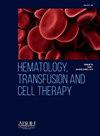PROTOCOL OF A RANDOMIZED PILOT STUDY ON SURVIVAL IN NEWLY DIAGNOSED GLIOBLASTOMA PATIENTS UNDERGOING CHEMORADIATION VERSUS COMBINED CHEMORADIATION WITH INTRANASAL PERILLYL ALCOHOL
IF 1.8
Q3 HEMATOLOGY
引用次数: 0
Abstract
Introduction/Justification
Glioblastoma multiforme (GBM) is a highly aggressive type of brain tumor and remains one of the most challenging cancers to treat. This tumor is characterized by rapid progression and unfavorable prognosis. After undergoing surgery, radiotherapy (RT), and chemotherapy (CT) with temozolomide (TMZ), patients generally exhibit low survival rates. Perillyl alcohol (POH) is a hydroxylated monoterpene with antitumor, anti-angiogenic, and pro-apoptotic properties, inhibiting RAS oncogene-mediated signaling. In vitro and in vivo studies showed POH's cytotoxicity to both TMZ-resistant and sensitive cells, and its effectiveness as a radiosensitizer in malignant glioma cell lines. In phase I/II trials with oral POH in advanced, refractory cancer patients, nausea and other gastrointestinal toxicities led to study discontinuation. Currently, POH is being studied as an inhaled anticancer agent, showing no toxicity and promising activity with increased survival in patients with recurrent gliomas, however, these studies were not randomized, and to date, these investigations have been conducted exclusively in patients with recurrent gliomas.
Objectives
This study presents a protocol from the University of Campinas, developed by experts across multiple fields, to evaluate the effects of intranasal POH in GBM patients.
Materials and Methods
Patient's will be recruited from the Oncology Service at the General Hospital of the University of Campinas (UNICAMP) after tumor resection, with a total of 40 participants. Adult individuals of any gender will be included. Through randomization, participants will be randomly assigned to two groups: the control group (RT+CT) and the intervention group (RT+CT+ POH inhalations). Block randomization of four patients will ensure balance between groups during recruitment. The randomization sequence was generated at www.randomization.com. The control group will undergo RT and CT with TMZ: 75 mg/m² of TMZ daily for 6 weeks during RT (2 Gy/day for 5 days a week, totaling 60 Gy), followed by 150 or 200 mg/m² of TMZ for 5 days per cycle in 28-day cycles for 6 cycles. The participants in the intervention group will receive the same treatment plus 0.3% POH inhalations (55 mg in 3 mL of water, 4 times daily, with 6-hour intervals). They will undergo 6 weeks of RT + TMZ + POH, followed by 6 cycles of TMZ + POH (5 days of TMZ + POH, followed by 23 days of POH only). Cranial MRIs will be analyzed by an expert neuroradiologist using T2/FLAIR signal intensity with perfusion, without knowledge of patient group allocation. MRIs are part of routine treatment, performed every 3-4 months in the first year, and response will be assessed using MacDonald and RANO criteria for high-grade gliomas. Toxicity assessment of standard treatment with POH will follow the NCI Common Terminology Criteria, version 5.0. Progression-free survival will be compared between patients receiving only RT and CT and those also undergoing POH inhalation, with survival curves calculated using the Kaplan-Meier method.
Results
Perspectives: Patients in the intervention group are expected to have higher survival rates, indicating a benefit of intranasal POH with standard treatment.
Conclusion
Acknowledgement: The study was supported by Coordenação de Aperfeiçoamento de Pessoal de Nível Superior (CAPES).
新确诊胶质母细胞瘤患者接受化疗与鼻内紫苏醇联合化疗的生存率随机试验研究方案
导言/理由多形性胶质母细胞瘤(GBM)是一种侵袭性极强的脑肿瘤,也是治疗难度最大的癌症之一。这种肿瘤的特点是进展迅速、预后不良。在接受手术、放射治疗(RT)和替莫唑胺(TMZ)化疗(CT)后,患者的存活率通常很低。Perillyl醇(POH)是一种羟基单萜,具有抗肿瘤、抗血管生成和促进细胞凋亡的特性,可抑制RAS癌基因介导的信号传导。体外和体内研究表明,POH 对 TMZ 抗性细胞和敏感细胞都有细胞毒性,而且在恶性胶质瘤细胞系中可作为放射增敏剂。在晚期难治性癌症患者口服 POH 的 I/II 期试验中,恶心和其他胃肠道毒性导致研究中止。目前,POH 作为一种吸入式抗癌剂正在进行研究,结果显示,POH 在复发性胶质瘤患者中无毒性,并且具有提高生存率的良好活性,但这些研究并非随机进行,迄今为止,这些研究仅在复发性胶质瘤患者中进行。材料和方法坎皮纳斯大学总医院(UNICAMP)肿瘤科将招募肿瘤切除术后的患者,共 40 人。任何性别的成年人均可参加。通过随机分配,参与者将被随机分配到两组:对照组(RT+CT)和干预组(RT+CT+吸入 POH)。四名患者的分组随机将确保招募过程中各组之间的平衡。随机序列在 www.randomization.com 上生成。对照组将在接受 RT 和 CT 治疗的同时接受 TMZ 治疗:在RT期间,每天注射75毫克/平方米的TMZ,持续6周(每周5天,每天2Gy,共60Gy),然后再注射150或200毫克/平方米的TMZ,每周期5天,28天为一个周期,共6个周期。干预组的参与者将接受相同的治疗,同时吸入 0.3% POH(55 毫克溶于 3 毫升水中,每天 4 次,每次间隔 6 小时)。他们将接受为期 6 周的 RT + TMZ + POH 治疗,然后接受 6 个周期的 TMZ + POH 治疗(5 天 TMZ + POH,然后 23 天仅 POH)。头颅核磁共振成像将由神经放射学专家使用 T2/FLAIR 信号强度和灌注进行分析,不了解患者的分组情况。核磁共振成像检查是常规治疗的一部分,第一年内每 3-4 个月进行一次,将采用 MacDonald 和 RANO 高级胶质瘤标准评估反应。POH标准治疗的毒性评估将遵循NCI通用术语标准5.0版。仅接受 RT 和 CT 治疗的患者与同时接受 POH 吸入治疗的患者的无进展生存期将进行比较,生存曲线将采用 Kaplan-Meier 法计算:干预组患者的生存率预计会更高,这表明鼻内吸入 POH 有助于标准治疗:本研究得到了Coordenação de Aperfeiçoamento de Pessoal de Nívelior (CAPES)的支持。
本文章由计算机程序翻译,如有差异,请以英文原文为准。
求助全文
约1分钟内获得全文
求助全文
来源期刊

Hematology, Transfusion and Cell Therapy
Multiple-
CiteScore
2.40
自引率
4.80%
发文量
1419
审稿时长
30 weeks
 求助内容:
求助内容: 应助结果提醒方式:
应助结果提醒方式:


